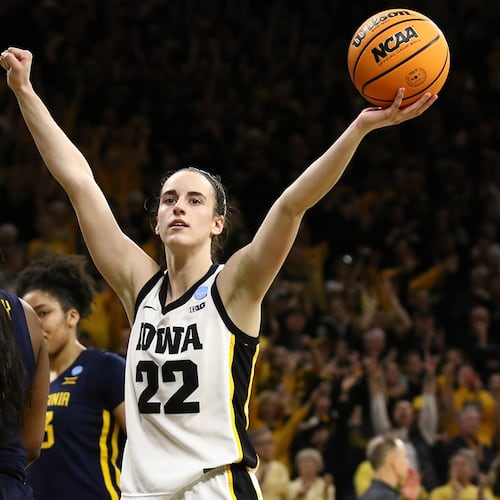This we know: Dansby Swanson starts fast. Over his first 38 big-league games in 2016, he hit .302. Over his first 11 games last season, he hit .366.
This we also know: At following through, he’s less good. In 2017, his first full season in the majors, he batted .232 with more strikeouts than hits and was, in late July, demoted to Triple-A. His rolling start of last season notwithstanding, he finished the year at .238. He also finished it injured. Soreness in his left wrist sidelined him in May. A torn ligament in his left hand, suffered in September, forced the Braves to omit their shortstop from the NLDS roster.
OK, there’s your caveat. Here’s what’s happening.
Through 11 games, Swanson is tied for second among National League hitters in RBIs (15); tied for sixth in home runs (4) and tied for 22nd in batting average (.324). He’s ninth in OPS (1.183). He’s seventh in WAR at 0.7, which over 162 games would be 10.3, which is unanimous-MVP caliber. But let’s not get ahead of ourselves.
We can’t yet know if this is Swanson just being Swanson — or if this is Swanson becoming a better Swanson. He had wrist surgery in November. He hit .353 with an OPS of .980 in spring training. He has homered in each of the Braves’ first four series. (His three-run shot broke open Tuesday’s game in Denver.) He has gone hitless twice in 11 games. His on-base percentage is .419, which is .101 above his career OPB.
The deeper you go, the more encouraging signs you see. The exit velocity of Swanson’s batted balls, per Baseball Savant, is 92.7 mph. That’s more than 3 mph above the MLB average; it’s also up from the 86.8 of Swanson’s 2017 and 2018 seasons. His percentage of balls classified as “hard-hit” is 56.0, up from the 31.8 of 2017 and the 34.0 of 2018. Of his 25 batted balls, five — 20 percent — have been counted as “barrels,” which is the optimum result. His career barrel percentage is 4.0.
Have your eyes glazed from all these numbers? Hang tight. These are the final two. Swanson’s strikeout percentage is 17.9, down from 22.9 of last season. His walk percentage is 15.4, up from 8.3. All the above suggests that he’s seeing the ball better and hitting it harder, which can happen even with bad hitters. The reason they’re bad hitters, though, is that the feeling never lingers. If Swanson can progress to being – forget .300 – a .275 hitter, the Braves will look rather different, meaning better still.
In the hoopla surrounding the advent of Ronald Acuna, we've tended to forget that Dansby Swanson once was a very big deal. He was the first player drafted in 2015. He was the centerpiece of John Coppolella's greatest trade. He made his big-league debut — and became the face of a franchise about to relocate to Cobb County, where he was born and raised — after only 127 minor-league games. He was Baseball America's No. 3 prospect in 2017, and he entered that season considered the front-runner to win rookie of the year.
A baseball man who works for an American League club believed the Braves, in the need to sell tickets for their inaugural season at SunTrust Park, had done Swanson a grave disservice by splashing his face and famous hair on billboards. The man also said, rather dismissively: “To me, he’s Blauser.”
We stipulate that Jeff Blauser was a solid shortstop — and twice an All-Star — in the Braves' decade of dominance. If Swanson is indeed another Blauser, that's not a worst-case scenario. But if Swanson is, as was once believed and his talent would suggest, better than that, the Braves will be bigger and bolder than they already are.
We also stipulate that the face/hair-of-the-franchise stuff was a reach. (Ask Justin Upton how oppressive it was when the Diamondbacks gave him the same treatment in Phoenix, and J. Upton is a really good player.) It was, however, a reach made in the hope of selling Braves Country that the dark days of the deep-dish rebuild were coming to an end. New ballpark, new team, new era.
Which is exactly what the Braves have become, though Swanson, once a focal point, was part of the supporting cast in last year’s division title. He ranked ninth among Braves in WAR at 2.3, and much of that came from his defense. (Remember when I said I was done with numbers? I lied.) He finished sixth among big-league shortstops in Ultimate Zone Rating and Defensive Runs Saved, and his glove more than justified his inclusion in the everyday eight. But a shortstop who can hit — a Francisco Lindor, a Carlos Correa, a Corey Seager — is something else altogether.
Plucking Swanson from Arizona six months after the D-backs made him the 1-1 pick was never seen as a mere building block. It was viewed as a ramp upward. No, Aaron Blair didn’t pan out, but Ender Inciarte has become both an All-Star and a serial Gold Glover. That said, Inciarte wasn’t the reason Coppolella made that deal. Swanson was.
His first two full seasons were OK. He has it within him to be much better than that. We’re seeing as much now. If we’re still seeing it come June, the Braves will have themselves another All-Star, which was kind of the idea all along.
About the Author
The Latest
Featured


